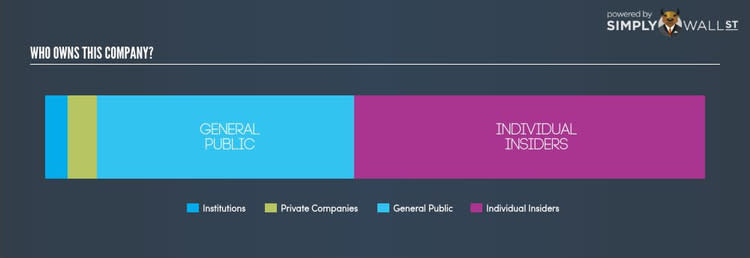What Does Grand Gulf Energy Limited’s (ASX:GGE) Ownership Structure Look Like?

In this analysis, my focus will be on developing a perspective on Grand Gulf Energy Limited’s (ASX:GGE) latest ownership structure, a less discussed, but important factor. The impact of a company’s ownership structure affects both its short- and long-term performance. Since the effect of an active institutional investor with a similar ownership as a passive pension-fund can be vastly different on a company’s corporate governance and accountability of shareholders, investors should take a closer look at XYZ’s shareholder registry. All data provided is as of the most recent financial year end.
Check out our latest analysis for Grand Gulf Energy
Institutional Ownership
Institutional investors transact in large blocks which can influence the momentum of stock prices, at least in the short-term, especially when there is a low level of public shares available on the market to trade. A low institutional ownership of 3.53% puts GGE on a list of companies that are not likely exposed to spikes in volatility resulting from institutional trading. Stocks with low coverage such as GGE, attracts renowned investor Peter Lynch, who has benefited from the momentum of institutions buying into a stock as it gained popularity.
Insider Ownership
Another important group of shareholders are company insiders. Insider ownership has to do more with how the company is managed and less to do with the direct impact of the magnitude of shares trading on the market. GGE insiders hold a significant stake of 53.07% in the company. This level of insider ownership has been found to have a negative impact on companies with consistently low PE ratios (underperformers), while it has been positive in the case of high PE ratio firms (outperformers). It may be interesting to take a look at what company insiders have been doing with their holdings lately. Insider buying may be a sign of upbeat future expectations, however, selling doesn’t necessarily mean the opposite as insiders may be motivated by their personal financial needs.
General Public Ownership
The general public holds a substantial 39.00% stake in GGE, making it a highly popular stock among retail investors. This size of ownership gives retail investors collective power in deciding on major policy decisions such as executive compensation, appointment of directors and acquisitions of businesses. Such level of ownership gives retail investors the power to sway key policy decisions such as board composition, executive compensation, and potential acquisitions. This is a positive sign for an investor who wants to be involved in key decision-making of the company.
Private Company Ownership
Potential investors in GGE should also look at another important group of investors: private companies, with a stake of 4.39%, who are primarily invested because of strategic and capital gain interests. However, an ownership of this size may be relatively insignificant, meaning that these shareholders may not have the potential to influence GGE’s business strategy. Thus, investors not need to worry too much about the consequences of these holdings.
What this means for you:
Are you a shareholder? Institutional ownership in GGE is not at a level that would concern investors. We are less likely to see sustained downtrends or significant volatility resulting from large institutional trading. If you’re looking to diversify your holdings with high-quality stocks, our free analysis platform has a selection of high-quality stocks with a strong growth potential.
Are you a potential investor? Ownership structure should not be the only determining factor when you’re building an investment thesis for GGE. Rather, you should be looking at fundamental drivers like the future growth expectations around GGE, which is a key factor that will influence GGE’s share value. Take a look at our most recent infographic report on GGE for a more in-depth analysis of these factors to help you make a more well-informed investment decision.
NB: Figures in this article are calculated using data from the last twelve months, which refer to the 12-month period ending on the last date of the month the financial statement is dated. This may not be consistent with full year annual report figures.
To help readers see pass the short term volatility of the financial market, we aim to bring you a long-term focused research analysis purely driven by fundamental data. Note that our analysis does not factor in the latest price sensitive company announcements.
The author is an independent contributor and at the time of publication had no position in the stocks mentioned.

